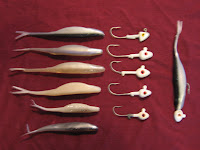Terminal tackle:
Barrel swivels and snaps- I usually make my own setups. The barrel swivels I use on big equipment can handle up to 90 lb test, the ones I use on light to medium equipment can handle 50lb test. I’ll never use that much on them but over kill in this area isn’t a bad thing. The very first thing I put on the end of any line is a barrel swivel snap combination. This makes it easy to change leaders and setups instantly. There are a lot of snap types but for making your own snap/swivels I like duolock snaps or Berkley crosslock snaps of the 2 the crosslocks are the best. Big stripers can trash must snaps when they get them in their mouths but I’ve yet to see them abuse a crosslock snap.


Leaders- There are basically 2 types of leaders monofilament and wire. I make my own and vary the length and strength depending on the type of fishing I’m going to do. The wire leaders are usually about 1 ½ ft long made out of 50 lb test black coated wire. On one end I put a barrel swivel on the other end I put a crosslock snap. I like them relatively long because they are predominantly for blues and when I catch a blue I’ll generally pick it up by the leader and remove the hook over the side of the boat.

Stripers will not hit anything with a wire leader on it for that reason you need mono leaders on board. I used to make monofilament leaders out of regular monofilament but in the last few years my friend Paul has turned me on to fluorocarbon and I’m hooked. Fluorocarbon is really tough and abrasion resistant. I only use two different lb tests 60 and 20. Heavy tackle gets the 60; light to medium tackle gets the 20. I usually put
 a barrel swivel and snap at either end, but often on the 20 lb test I’ll use the barrel swivel with just line to tie directly to the lure on the other end. The general rule for length is 3 ft that’s enough so the fish wont see the snaps and swivels.
a barrel swivel and snap at either end, but often on the 20 lb test I’ll use the barrel swivel with just line to tie directly to the lure on the other end. The general rule for length is 3 ft that’s enough so the fish wont see the snaps and swivels.Soft Plastics-Hands down the best baits for striped bass in the schoolie class 14-34 inches. These are deadly and what I use most for boat and shore schoolies. The problem is if there are blues mixed in they will get chopped up like confetti. For that reason I bring a bunch of them.
Zoom fluke- Lots of color choices a couple of different sizes 3” and 4”. Great lure for smaller stripers 14”-24” inches and sometimes big ones if their feeding on small bait. You can use them with a variety of jig heads. My favorites ¼oz-3/8oz jig head with smoking shad color or pearl color.




Buck tail jigs- They’ve been around since the stone age and they still work real
Poppers-I love catching fish on top and poppers are the lure of choice for that kind of action. They come in a variety of colors and sizes. Most people use poppers that are way to big. I make my own and usually don’t fish any that are bigger than 4” long and ¾ “ diameter. Sometimes I’ll use poppers as small as 2 “ long with a 3/8 “ diameter. Stripers seem to love a silver body with a green back. When your fishing for stripers a buck tail attached to the back hook is really helpful. When it comes to blues color and buck tail is not that important just skim it fast and hang on. This is the most effective lure for blues when hey are near the surface.

The secret weapon- This is real old school but some times you need to cast a relative light lure (zoom fluke, cocahoe, small buck tail jig, wild eye shad) a long distance. When fish are boat shy or when your fishing for shore this is the trick. Go to a craft store buy a wooden egg. Place a screw eye at each end or drill a hole straight through and use some plumber’s wire with a loop at each end (this is the strongest and best way). Put a small finish nail in the egg at an angle to act as a keeper for the lure. Tie a 3ft or somewhat longer piece of leader material to one end of the egg and tie any of the above lures at the other end connect it to the snap on the line and you’ll be able to launch things a mile.











